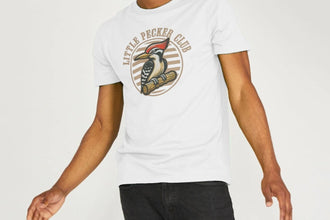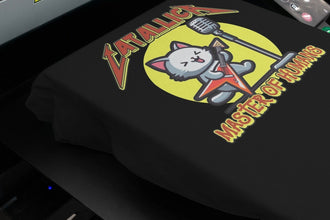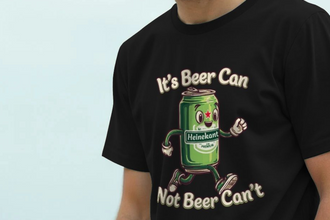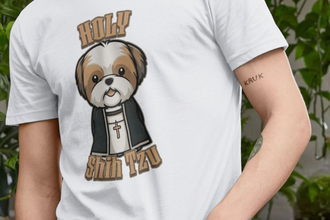
The Comprehensive Guide to T-Shirt Printing Methods: From Our Manchester Workshop to Your Wardrobe!
Alright, chuck! Ever wondered how your favourite t-shirt got its snazzy design? It's all thanks to the magic of t-shirt printing, a craft that's been around for ages and is more popular than ever! Whether you're rocking a band tee, showing off your witty slogan, or just repping your favourite footie club, chances are your tee went through a printing process.
Here at Teevolution, your friendly, family-run online t-shirt emporium in the heart of Manchester, we're passionate about all things tees. We're not just about slinging threads; we're about putting a smile on your face with every wear (and maybe even sparking a conversation or two!). We're the type to crack a cheeky pun over a pint down at the local, all while championing eco-friendly practices, like using vegan-friendly, organic cotton, carbon-neutral tees, designed in factories powered by renewable energy.
But with so many printing methods out there, choosing the right one can feel like navigating a Manchester roundabout at rush hour – confusing! That's why we've put together this comprehensive guide, your one-stop shop for everything t-shirt printing. We'll mainly be talking you through screen printing and digital printing (DTG) – the two big hitters. We will touch on other methods too.
So, grab a brew, settle in, and get ready to become a t-shirt printing pro!
I. T-Shirt Printing: A Brief Overview
From humble beginnings to a multi-billion-pound industry, t-shirt printing has come a long way. It's more than just slapping a design on fabric; it's an art form that allows you to express yourself, promote your brand, or simply spread a bit of joy.
What We'll Cover:
- Screen Printing: The classic, tried-and-true method.
- Digital Printing (DTG): The modern, high-tech alternative.
- Other Methods (Briefly): Heat transfer, dye sublimation, and more.
- Comparison: A head-to-head battle to help you choose the right method.
Ready? Let's dive in!
II. Screen Printing: A Detailed Look
Screen printing, also known as silkscreen printing, is like the granddad of t-shirt printing methods. It's been around for ages, and for good reason – it's reliable, versatile, and perfect for certain types of designs.
What is Screen Printing?
Imagine using a stencil to paint a picture. That's essentially what screen printing is! A design is blocked off on a mesh screen, and ink is forced through the open areas onto the fabric below. Each colour needs its own screen, layering them one by one to create the final image.
The Process, Step-by-Step:
- Creating the Stencil/Screen: A fine mesh screen is coated with a light-sensitive emulsion. A film positive of your design is placed on the screen, and it's exposed to UV light. The light hardens the emulsion, while the areas covered by the design remain soft. These soft areas are then washed away, leaving a stencil of your design on the screen.
- Applying Ink Layers: The screen is placed on top of the t-shirt, and ink is spread across the screen using a squeegee. The ink passes through the open areas of the stencil, transferring the design onto the fabric.
- Curing the Ink: Once all the colours have been applied, the t-shirt is passed through a heat tunnel to cure the ink. This process sets the ink into the fibres of the fabric, making it durable and long-lasting.
Pros of Screen Printing:
- Cost-Effective for Large Orders: The more you print, the cheaper it gets per shirt. Ideal for bulk orders (band merch, team uniforms, etc.).
- Durable Prints: Screen-printed designs are known for their longevity and resistance to fading or cracking.
- Vibrant Colours: Screen printing can achieve bold, eye-catching colours, especially on darker fabrics.
- Ideal for Bold, Simple Designs: Works best with designs that don't have too many colours or gradients.
Cons of Screen Printing:
- Not Ideal for Complex Designs: Too many colours or intricate details can make it expensive and challenging.
- High Setup Costs: Creating the screens can be pricey, especially for small orders.
- Limited Colour Options: Matching exact colours can be tricky, and gradients are difficult to achieve.
- Less Eco-Friendly (Potentially): Traditional screen printing inks can contain harmful chemicals. (At Teevolution, we only use eco-friendly inks!).
III. Digital Printing (DTG): A Modern Approach
Digital printing, or Direct-to-Garment (DTG) printing, is the new kid on the block, bringing a whole new level of flexibility and detail to the t-shirt printing game. DTG is Teevolution's weapon of choice, for saving the planet.
What is Digital Printing?
Think of it like printing on paper, but with a t-shirt instead! DTG printers use inkjet technology to spray ink directly onto the fabric. It's a bit like having a mini-printer for clothes.
The Process, Step-by-Step:
- Preparing the Garment: The t-shirt is pre-treated with a special solution to help the ink adhere to the fabric.
- Printing Directly onto the Fabric: The t-shirt is placed on the printer, and the design is printed directly onto the fabric using specialized inkjet heads.
- Curing the Ink: Just like with screen printing, the t-shirt is passed through a heat tunnel to cure the ink, ensuring a durable and long-lasting print.
Pros of Digital Printing (DTG):
- Excellent for Complex Designs: DTG can handle intricate details, gradients, and unlimited colours with ease.
- Low Setup Costs: No screens needed! This makes it ideal for small orders or one-off prints.
- Photorealistic Prints: DTG can reproduce photographs and other complex images with stunning accuracy.
- More Eco-Friendly (Generally): DTG printers use water-based inks, which are gentler on the environment.
Cons of Digital Printing (DTG):
- More Expensive for Large Orders: The cost per shirt doesn't decrease as much as with screen printing, making it less economical for bulk orders.
- Works Best on Light-Coloured Fabrics: DTG can struggle to achieve vibrant colours on dark fabrics. But at Teevolution. we work around this by printing a white base print on first and then we print our graphic on top of the bright white base coat. This makes our unique designs, even more vibrant than printing on a white garment. Clever Eh!
- Slower Printing Speed: DTG printers are generally slower than screen printing setups.
IV. Screen Printing vs. Digital Printing: A Head-to-Head Comparison
Okay, let's get down to the nitty-gritty. Here's a side-by-side comparison to help you decide which method is right for your project:
| Feature | Screen Printing | Digital Printing (DTG) |
|---|---|---|
| Image Complexity | Best for simple, bold designs | Excellent for complex designs, photos, and gradients |
| Colour Options | Limited colour options; gradients are difficult | Unlimited colour options; photorealistic prints |
| Print Durability | Very durable; resists fading and cracking | Creates a durable, brighter print and is resistant to cracking |
| Cost (Small Orders) | Expensive due to setup costs | Affordable due to no setup costs |
| Cost (Large Orders) | Cost-effective; price per shirt decreases significantly | More expensive; price per shirt remains relatively high |
| Fabric Types | Works well on a variety of fabrics | Best on light-coloured, 100% cotton fabrics or printing a white base print beforehand |
V. Choosing the Right Method for Your Needs
So, which method should you choose? Here are some factors to consider:
- Design Complexity: Is your design simple and bold, or intricate and colourful?
- Order Quantity: Are you printing a few shirts or a whole batch?
- Budget: How much are you willing to spend per shirt?
- Fabric Type: What kind of fabric are you printing on?
- Desired Durability: How long do you want the print to last?
Examples:
-
Screen Printing:
- Band t-shirts with a simple logo.
- Team uniforms with a single-colour design.
- Promotional t-shirts for a local business.
-
Digital Printing (DTG):
- Custom t-shirts with a photograph.
- T-shirts with intricate artwork or gradients.
- Small runs of personalised t-shirts.
- With less waste DTG is a lot better for the environment.
VI. Conclusion: Teevolution's Take on the Printing Process
Choosing the right t-shirt printing method can feel overwhelming, but hopefully, this guide has shed some light on the subject. Screen printing is the trusty old method, perfect for bold designs and budget-friendly bulk orders. Teevolution's preference is Digital printing (DTG) which is the modern marvel, nailing intricate details and vibrant colours, even on small runs.
At Teevolution, we believe in making sustainable choices, no matter which method we use. We source our cotton responsibly, use eco-friendly inks, and offer recycling options to minimise our environmental impact.
So, whether you're after an environmentally friendly, digitally printed masterpiece, we've got you covered. We are just a friendly, reliable, and we never take life too seriously – because, let’s be honest, life’s better with a laugh!
Join the Teevolution, save our world and wear tees that are not just stylish but planet-friendly, too!
Ready to get started? Get in touch today, and let's create some legendary tees!










